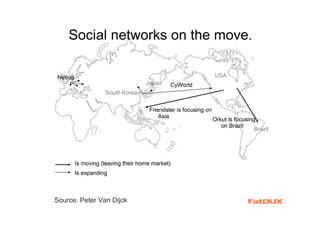Social And Anti Social Media
- 1. Social and anti-social media Web 2.0 Cult of the amateur From street cred to conversion Eric Reiss Copenhagen Business School Copenhagen, Denmark
- 2. What is Web 2.0?
- 3. “Web 2.0 is the business revolution in the computer industry caused by the move to the Internet as platform, and an attempt to understand the rules for success on that new platform.” Tim O’Reilly
- 4. (We didn’t understand it either)
- 5. Growth of the web Static sites = 1-way communication Web apps = 2-way communication Social apps = many-way communication
- 6. The three sides of Web 2.0 Technical (AJAX, RIA) Content (user-generated content) Ability to embrace the “long tail” Top 2.0 apps: Wikipedia (knowledge sharing) Blogger (opinion sharing) Twitter (microblogging) Digg (social bookmarking) Flickr (image sharing) YouTube (video sharing) Facebook (social networking)
- 7. The long tail / tall neck Sales volume or value Tall neck Long tail Products ranked by popularity
- 10. Wiki Content collection that can be edited by anyone using very simple markup language. Hawaiian word for “fast” Used for intranets and KM tools Less dangerous than many think Public-access wikis are usually self-healing within minutes Only slightly more errors in Wikipedia than Encyclopedia Britannica (says the Observer) Errors in print live for a full edition (i.e. years)
- 14. Blog Weblog Coined by Peter Merholz “We Blog” (1999) According to Dave Weinberger: “In the future, everyone will be famous to 15 people” Popular platforms: WordPress Blogger Moveable Type Given rise to interesting navigational form: tag clouds
- 16. Four types of blogs Blogs are short-form journals Notebooks feature longer pieces of focused content Filters are focused on links Microblogs are the SMS of online
- 17. Blog
- 18. Notebook
- 19. Filter
- 20. Microblog
- 21. Whyblog? Create buzz Lower communications barriers Build trust through openness
- 22. Social bookmarking Share references, not actual media All tagging is done by humans, not spiders Builds collective intelligence Better, more accurate results But no standard keywords every man for himself...
- 29. Goals of SEO (the bad reasons) Get to the top of Google Get a zillion hits
- 30. Goals of SEO (the real reasons) Get properly indexed by: Google MSN Yahoo! Specialized search engines Turn up in relevant searches Get people to click on your site first
- 31. Let’s kill two myths about SEO Forget keyword density. You cannot bore your visitors into buying your product. Forget page rank. In theory, you want to be the only page that turns up for a specific search.
- 32. Four keys to SEO Write worthwhile content Build shared references Answer questions Create value Write relevant metadata Title Keywords Description Alt text for graphics Write clean code <h1>Headline tags</h1> <p>Call to action closing paragraphs</p> Close “if” and “while” statements Get listed: Open Directory Yahoo! LookSmart
- 34. Media sharing Shares media, not just references Usually refers to photos, graphics, video Can also share word-based documents Comments and ratings Builds collective user value Now building closer links to other tools e.g. Flickr and Twitter
- 37. Social networking / communities Ego as focus (social networking) LinkedIn Xing Orkut Facebook Myspace Friendster Netlog CyWorld Ego as member (community)
- 42. Source: Peter Van Dijck
- 43. Source: Le Monde, 2007
- 44. Stuff to consider... Center on language, not on land Standardize, then localize Users of the same service are not necessarily the same One car, two drivers The world is regional, not national Incredibly inspired by Peter Van Dijck
- 45. Why doesn’t business believe us?
- 46. 1980 Then Now
- 47. 1980 Then Now “Dress for success” “Personal image is everything” “Work hard, feel proud, “Work hard, feel tired, get ahead.” miss out.” “Employers are “Employees are to be respected.” to be respected.” “I’m loyal.” “I’m a free agent.”
- 48. Fundamentals of change management
- 49. Why What How
- 50. So if we do want to use these tools, what’s holding us back?
- 51. Time. Money. Fear. Stupidity.
- 52. Traditional marketing vs. SMM Then Now Demographics Behavior We controlled the message Our customers create the buzz We asked our customers Our customers are having what they thought a conversation with our brand We dictated We serve
- 53. Customer service is the new marketing
- 54. Is there a secret to success? YES!
- 55. Have authentic conversations Think of technology like blogs, forums, and discussion boards as amplifying customer opinion rather than improving it.
- 56. 10 steps to authenticity 1. Don’t wait for conversation: Initiate it 2. Publish the real story of your company or organization 3. Publish your views on privacy and support (define your relationship) 4. Listen, internalize, and respond thoughtfully. 5. Help people learn about your product at their own pace 6. Make feedback a top priority (make it easy to provide) 7. Form a partnership with your customers (work with them) 8. Make authentic conversations a part of the culture 9. Anticipate and act on change 10. Hire a community manager Source: Joshua Porter
- 57. 10 greatest SMM mistakes 1. Lying (Karen video, Arla blog) 2. Ignoring (Dell Hell) 3. Denying (openly refusing to acknowledge a problem) 4. Arguing (corporate discussion boards) 5. Hyping (blatant promotion) 6. Gaming (padding ratings) 7. Hiding (no clear points of contact) 8. Hating (unwillingness to engage) 9. Censoring (removing negative comments) 10. Failure to embrace SM Source: Eric Reiss
- 58. You can (usually) find Eric at: The FatDUX Group ApS Strandøre 15 DK-2100 Copenhagen Denmark Office: (+45) 39 29 67 77 Mobil: (+45) 20 12 88 44 Twitter: @elreiss er@fatdux.com www.fatdux.com


























































